Rust Family Foundation: Archaeology Grants Program
Waun Mawn stone circle: the Welsh origins of Stonehenge
Principal Investigator: Michael Parker Pearson
Professor, Institute of Archaeology, University College London
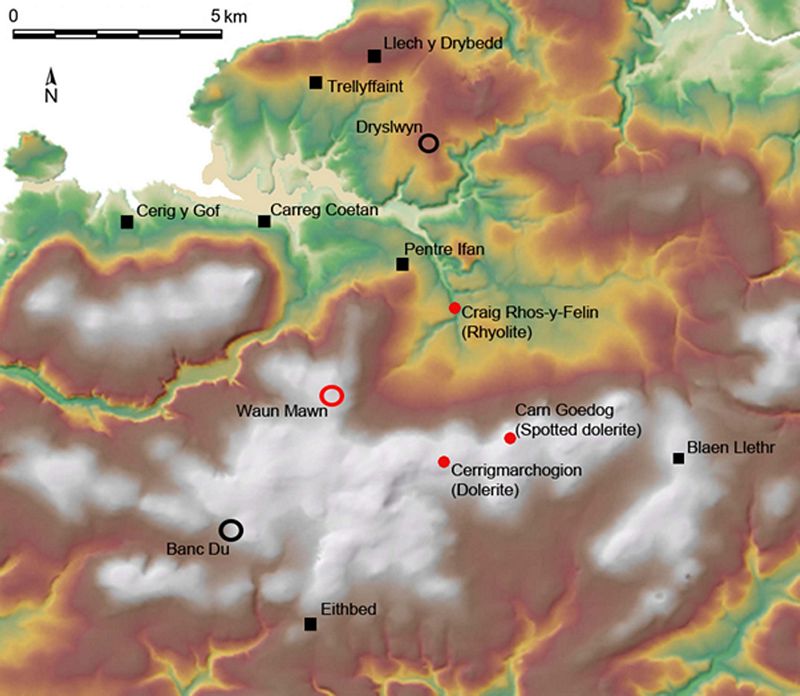
One of the great mysteries of prehistory is why Stonehenge’s ‘bluestones’ came from over 140 miles away in west Wales. While Stonehenge’s sarsen stones are thought to be local to the Avebury area, 20 miles to the north, the smaller bluestones (mostly weighing 1–3 tons) came from the Preseli hills of west Wales. Our aim is to find out why Stonehenge was built of stones from such distant sources.
Fig.1: Waun Mawn in relation to identified bluestone sources (red). Black squares are Neolithic tombs and black circles are Neolithic enclosures.
Previous Work at the Site:
Over the last seven years, the Stones of Stonehenge project has identified and excavated two of the outcrops from which bluestones were quarried in c.3300–3000 BC, before these megaliths were erected at Stonehenge in its first stage in c.3000–2920 BC. Archaeologists and geologists have hypothesised that Stonehenge’s bluestones might have first been erected as a stone circle in west Wales,
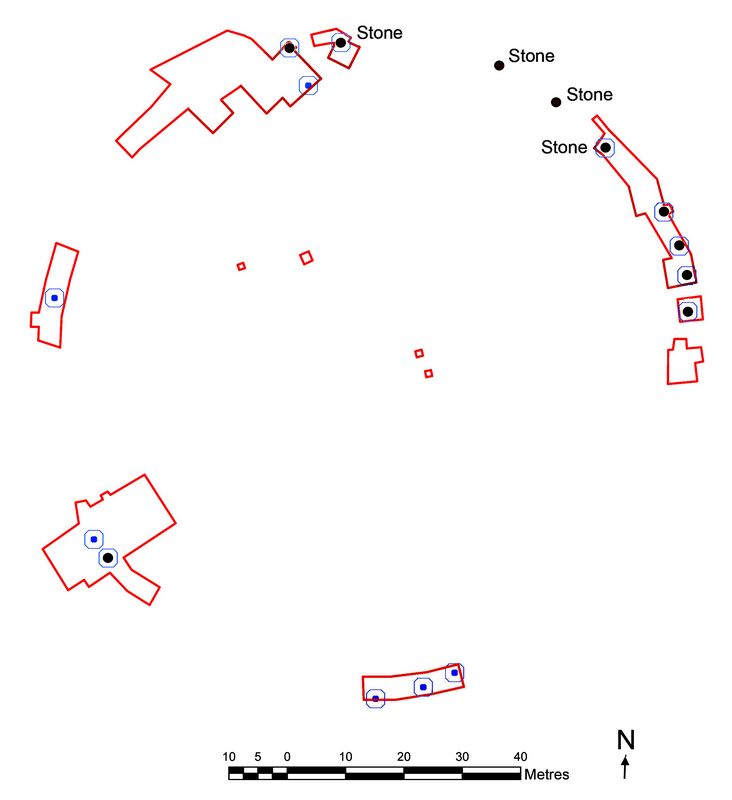 that was later dismantled and moved to Salisbury Plain, rather than being brought directly from their quarries.
that was later dismantled and moved to Salisbury Plain, rather than being brought directly from their quarries.In 2017, the Rust Family Foundation sponsored trial excavations at the partial stone circle of Waun Mawn that led to the identification of two stone sockets beyond each end of an arc of four monoliths (one still standing and three fallen), in close proximity to three of Stonehenge’s bluestone sources (RFF-2017-23). A suite of geophysical surveys conducted in 2018 (including ground-penetrating radar, resistivity, magnetometry and electro-magnetic induction) failed to identify any further features, most likely due to the difficult terrain and geology.
Fig.2: Stones and stone sockets (black circles) and other cut features (blue) at Waun Mawn. An artificial mound surrounded the easternmost stone.
Results of Current Funded Project (RFF-2018-65):
Goals:
The current project aims to establish whether there was indeed a stone circle (or stone circles) in west Wales from which the bluestones were taken.
Methodology:
Archaeological excavations at the partial stone circle at Waun Mawn uncovered stone holes of two of its four remaining monoliths and revealed 12 further features extending beyond the ends of the arc of monoliths. Six of these features were holes for standing stones removed in antiquity (figs.4-6). Radiocarbon dating and optically stimulated luminescence (OSL) dating were carried out to find out when the circle was constructed and taken down.
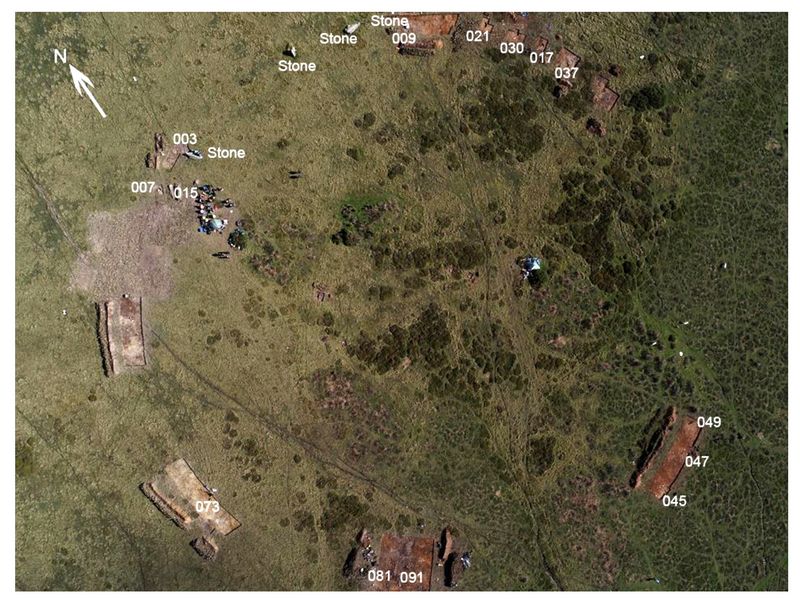
Fig.3: Locations of excavated features with context numbers at Waun Mawn.
Together with the four remaining monoliths at Waun Mawn, the six stone sockets excavated in 2018 form part of a former stone circle with a diameter of c.110m. This
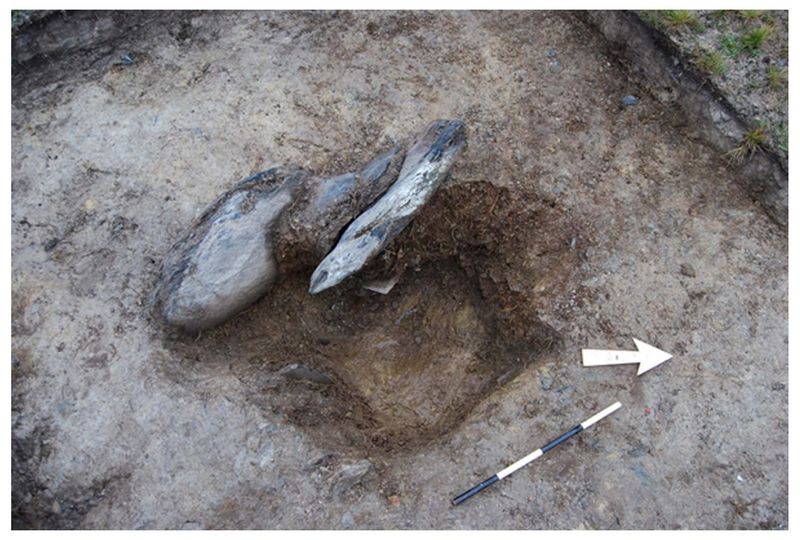 makes Waun Mawn the third largest stone circle known in
Britain, after Avebury and Stanton Drew.
makes Waun Mawn the third largest stone circle known in
Britain, after Avebury and Stanton Drew.Fig.4: Stone socket 007, from which a standing stone was removed in antiquity. The stone’s imprint can be seen to the left of the north arrow.
The empty sockets contained the imprint of the monoliths that had each stood in these holes. They range in size from 0.2m across to 0.6m across and were mostly held in place with packing stones before their removal in prehistory.
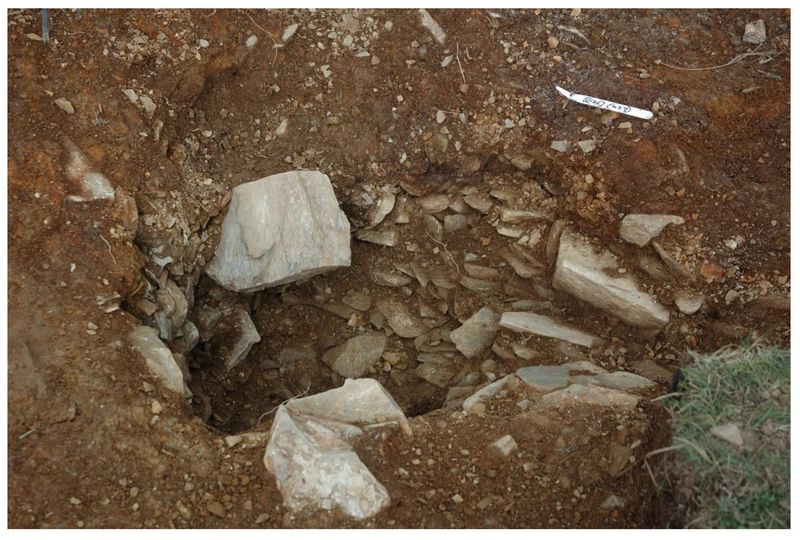
Fig.5: Stone socket (030) from which a standing stone was removed in antiquity. The two large packing stones lie either side of the void left by removal of the rectangular standing stone.
OSL and radiocarbon dating:
OSL dating, funded in part by RFF-2018-65, has revealed that the stones that once stood in these sockets were put up in 3530±330 BC (in the Neolithic) and removed
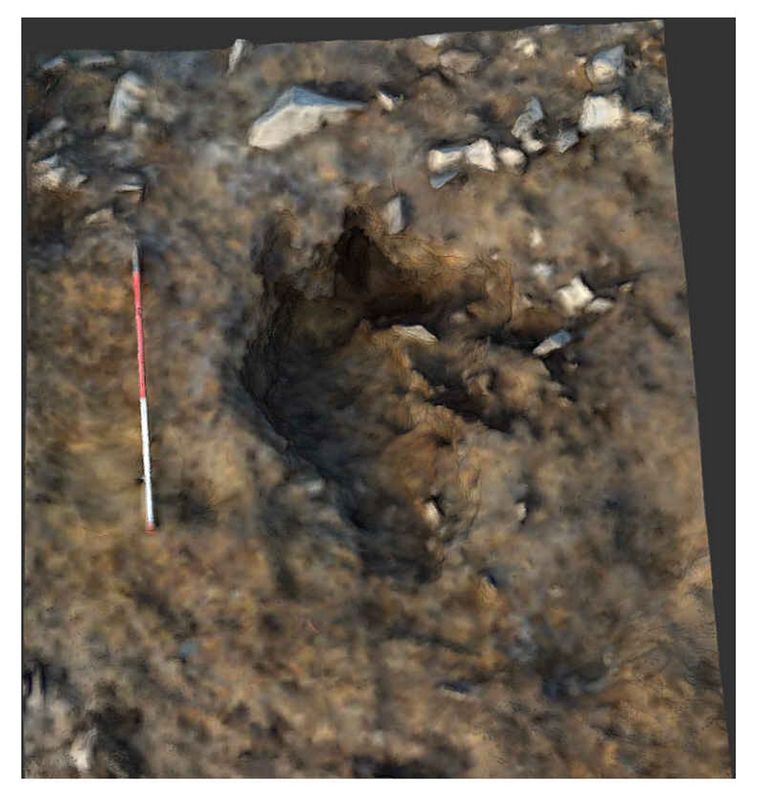 before 2120±520 BC (i.e. most likely during the
Neolithic). The only carbonised materials recovered from the fills of
the stone sockets were tiny pieces of wood charcoal, mostly of oak and
hazel. Some of these are large enough for radiocarbon-dating, and six
fall within the range of the OSL dates, suggesting construction of the
stone circle in c.3400–3200 BC.
before 2120±520 BC (i.e. most likely during the
Neolithic). The only carbonised materials recovered from the fills of
the stone sockets were tiny pieces of wood charcoal, mostly of oak and
hazel. Some of these are large enough for radiocarbon-dating, and six
fall within the range of the OSL dates, suggesting construction of the
stone circle in c.3400–3200 BC. Fig.6: 3-D image of Stone socket 091, showing the ramp on its south side (lower centre) along which the standing stone was introduced and removed.
Potential links with Stonehenge:
The largest of the stones removed from the circle in prehistory left an unusual pentagonal-shaped imprint of its base (in stonehole 091; fig 6) which can be matched with the basal cross-section of Stone 62 at Stonehenge. A large flake of dolerite that appears to have become detached from the Waun Mawn monolith during its erection or removal, is of the same type of rock as that of Stone 62 at Stonehenge.
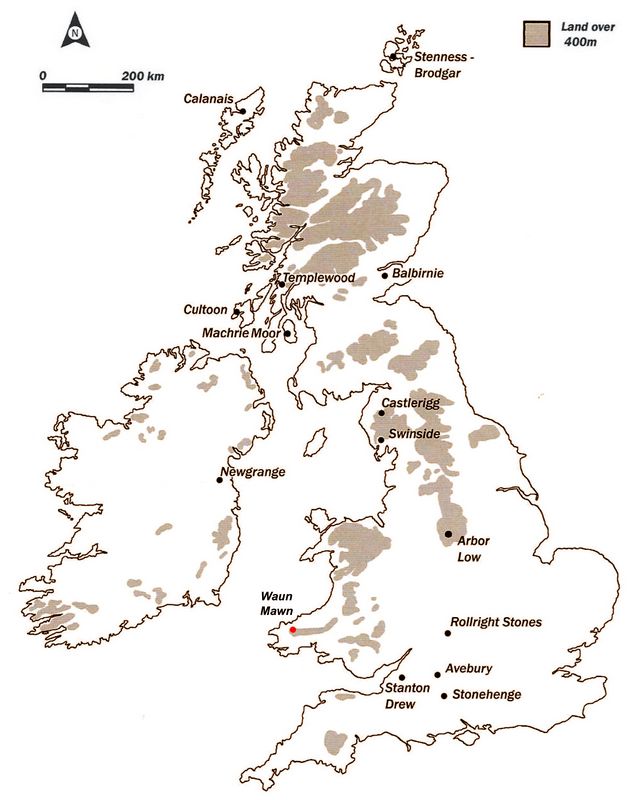
Further potential links with Stonehenge are provided by the discovery that one of the former standing stones on the northeast sector of the circle (from stonehole 009), together with a stonehole east of it (stonehole 021), formed an entrance aligned from the circle’s centre towards midsummer solstice sunrise. Secondly, the diameter of Waun Mawn circle is the same as the diameter of Stonehenge’s perimeter ditch; no other Neolithic monuments in Britain are known to share this diameter (fig.8).
Fig.7: The great stone circles of Britain.
Conclusion:
Like the other great stone circles of Britain, Waun Mawn dates to the Neolithic. It was constructed around the same time or shortly before Long Meg and Her Daughters in Cumbria (3340–3100 BC) but before Stonehenge (3000–2920 BC) and probably before Avebury in Wiltshire and the Ring of Brodgar in Orkney (fig,7).
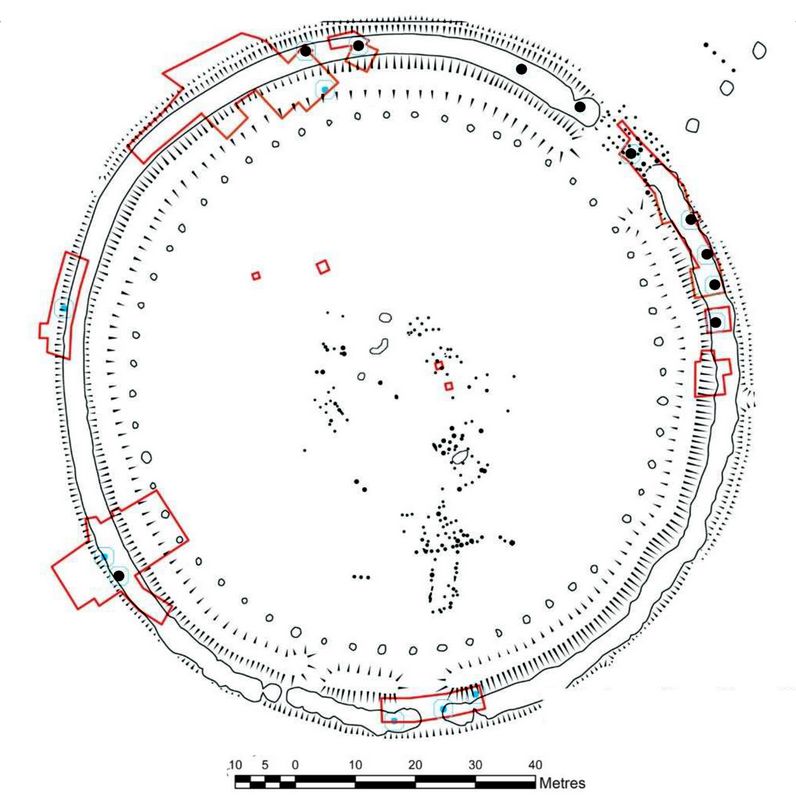
Together with a Neolithic causewayed enclosure at Banc Du, a Neolithic palisaded enclosure at Dryslwyn, and seven Neolithic tombs, it forms a major ceremonial complex within the Preseli hills and their environs. This provides a new insight into the significance of the source of Stonehenge’s bluestones, and raises interesting new questions about the relationship of this complex in Preseli with that on Salisbury Plain, such as why Stonehenge was built out of one or more second-hand monuments.
Fig.8: The stones and stone sockets of Waun Mawn overlaid on the plan of Stonehenge stage 1. These are the only two Neolithic monuments in Britain known to share the same diameter of 110m.
References:
Parker Pearson, M., Pollard, J., Richards, C.,Welham, K. Casswell, C., Shaw, D., Simmons, E., Stanford, A., Bevins, R.E. and Ixer, R.A.
2019 Megalithic quarries for Stonehenge’s bluestones. Antiquity 93: 45-62.
.
Recent Foundation grants: general Archaeology Grants Program w/map
Copyright © 2020 Rust Family Foundation